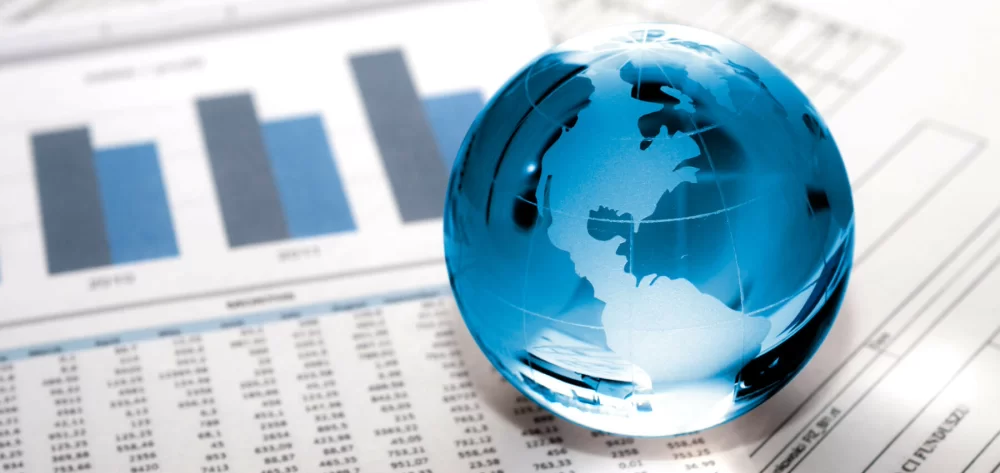Many investors use global stock indices as a tool for diversifying their investment portfolios. This moneyland.ch guide answers the most important questions about world ETFs.
What is a global stock index?
A global index is an international stock index that is designed to be a benchmark of the worldwide stock market. The principle is similar to that used for national benchmark stock indices like the Swiss SMI and the German DAX. But instead of tracking companies in a single country, global stock indices track companies all over the world. Most global stock indices are denominated in US dollars.
There are no clearly defined criteria for the makeup of global indices. Most of these indices use market capitalization as the primary criterion for determining which stocks are included.
Which global stock indices are there?
There are numerous indices that are meant to fully or largely reflect the global stock market. But a look at major indices shows that most indices are not truly global, in the strict sense of the term. While they do represent a large share of worldwide market capitalization, there are numerous countries that are not represented. Many of these indices exclude entire continents. For example, only one of the six major global indices listed below includes African stocks (see Table 1).
Table 1: Major global stock indices compared
| Index |
Number of
stocks |
Number of
countries |
Continents |
Global market
capitalization |
| Dow Jones Global Titans 50 Index |
53 |
11 |
Asia, Europe, North America |
No information |
| FTSE All-World |
4293 |
49 |
Africa, Asia, Australia/Oceania,
Europe, North America,
South America |
Around 90-95% |
| FTSE Developed |
2117 |
25 |
Asia, Australia/Oceania, Europe,
North America |
No information |
| MSCI All Country World Index |
2946 |
47 |
Asia, Australia/Oceania, Europe,
North America |
Around 85% |
| MSCI World |
1509 |
23 |
Asia, Australia/Oceania, Europe,
North America |
Around 85% |
| S&P Global 1200 |
1200 |
31 |
Asia, Australia/Oceania, Europe,
North America, South America |
Around 70% |
Information as per data provided by index publishers. Date: December 21, 2023.
All of the global indices listed above are price indices. That means their performance does not account for dividends. A performance index, on the other hand, accounts for dividends in its performance.
How can I invest in global stock indices?
The simplest and most cost-effective way to invest in global stock indices is to buy shares in an exchange-traded fund (ETF) for the index of your choice. These index funds, which are traded on stock exchanges, invest in the stocks tracked by an index with the aim of replicating the index’s performance as accurately as possible. The ongoing cost of using these funds, the total expense ratio (TER), is relatively low, especially when compared to actively managed mutual funds. All you need in order to buy shares in an ETF is a stock brokerage account from a Swiss bank, or an account with one of the Swiss neobanks Yuh or Neon. Be aware that neobanks have a limited selection of ETFs, so some of the ETFs listed in Table 2 may not be available.
Alternatively, you can also use a digital asset management service (robo advisor) like True Wealth, Selma, Clevercircles, Cleverinvest, or Swissquote Invest Easy. While many robo advisors do not let you choose which ETFs should be included in your investment portfolio, many Swiss robo advisors do make use of ETFs based on global indices. You pay an asset management fee on top of the fund TERs, but in exchange, you avoid brokerage fees, and the robo advisor handles the investing for you.
Table 2: The cheapest ETFs for global stock indices based on TER
| ETF |
Domicile of fund |
TER |
Dividends |
Index replication method |
| Dow Jones Global Titans 50 Index |
Lyxor DJ Global Titans 50 ETF Dist
(ISIN: FR0007075494) |
France |
0.40% |
Distributing |
Synthetic |
| FTSE All-World Index |
Invesco FTSE All-World
UCITS ETF Acc
(ISIN: IE000716YHJ7) |
Ireland |
0.15% |
Accruing |
Sampling |
| FTSE Developed Index |
Vanguard FTSE Developed World
UCITS ETF Distributing
(ISIN: IE00BKX55T58) |
Ireland |
0.12% |
Distributing |
Sampling |
| MSCI All Country World Index |
iShares MSCI ACWI UCITS ETF (Acc)
(ISIN: IE00B6R52259) |
Ireland |
0.20% |
Accruing |
Sampling |
| MSCI World Index |
UBS ETF (IE) MSCI World
UCITS ETF (USD) A-acc
(ISIN: IE00BD4TXV59) |
Ireland |
0.10% |
Accruing |
Sampling |
UBS ETF (IE) MSCI World
UCITS ETF (USD) A-dis
(ISIN: IE00B7KQ7B66) |
Ireland |
0.10% |
Distributing |
Sampling |
| S&P Global 1200 |
FNB Global 1200 Fund of Funds ETF
(ISIN: ZAE000303145) |
South Africa |
0.40% |
Distributing |
Optimized sampling |
Table 2 shows the cheapest available ETF for each global index based on TER. Date: December 21, 2023.
All of the ETFs shown in Table 2 are denominated by the US dollar, except for the FNB Global 1200 Fund of Funds ETF, which is denominated by the South African rand. Make sure to account for the risk of foreign currencies losing value against the Swiss franc.
Using ETFs that are domiciled in Ireland is advantageous from a tax perspective.
How much does it cost to invest using ETFs?
The total expense ratio (TER), which shows the annual cost of using a fund, is the most important factor. But in addition to the fees charged by the ETF itself, there are also other costs to pay attention to. Your bank may charge you brokerage fees when you buy and sell shares in an ETF. Brokerage fees vary broadly between banks. Custody fees also vary between banks.
Swiss stamp duties are another cost to be aware of. These are identical no matter which Swiss bank you use.
Some ETFs are listed on more than one stock exchange, in which case they may be traded in several different currencies. Many banks let you choose between several different stock exchanges for buying the same ETF. In this case, which exchange you choose does not generally make a substantial difference.
What are the issues and risks of global stock indices?
Global indexes are relatively well-diversified. But in spite of that fact, you as an investor are not protected from potential losses. Investing in stocks always comes with a risk.
It is also important to relativize the diversification of these indices. While they do normally cover many countries and industry sectors, and the lion’s share of global market capitalization, a closer look at their compositions reveals a clear imbalance. Developed countries are strongly over-represented in comparison to developing countries.
In most global indexes, just the United States alone makes up much more than half of the total index (see Table 3). Developing countries are normally not included at all. Indicators like a country’s population or gross domestic product (GDP) are not accounted for.
Table 3: US components of global stock indices
| Index |
Percentage of index made up of US stocks |
| Dow Jones Global Titans Index |
83% |
| MSCI World |
70.07% |
| FTSE Developed |
67.76% |
| S&P Global 1200 |
66.8% |
| MSCI All Country World Index |
62.72% |
| FTSE All-World |
61.12% |
Date: December 21, 2023.
Global indices primarily include large corporations. Small and mid-sized companies are usually not represented, despite their substantial economic significance.
Because most international stock indices are denominated in US dollars, investors in Switzerland are also exposed to a currency exchange risk. If the US dollar were to lose value against the Swiss franc, that would have a negative impact on your real returns.
What are the alternatives?
If you want to geographically diversify your investment portfolio but find the dominance of US stocks in global indices limiting, you can use other international stock indices in place of or in conjunction with major global indices. Many index publishers, including MSCI, also offer versions of their global indices that explicitly exclude US stocks.
You can also use many different ETFs that invest in specific regions or countries. This enables you to avoid the imbalances of global stock indices and to choose how much weight you give to different regions.
Examples of regional indexes include the STOXX Europe 600 index, the S&P Africa 40 index, and the S&P Latin America 40 index. If you want to narrow down your portfolio components to specific countries, you can use national indices like the Swiss SMI, the German DAX, or the French CAC 40. Just be aware that if you opt for this strategy, you will have to invest in many different ETFs in order to get a similar diversification to that offered by global indices.
Indices that focus on high-growth regions and developing countries can also be used to diversify your portfolio. Examples include the MSCI Emerging Markets Index and the MSCI Frontier Markets Index.
Which global stock index has the best performance?
The MSCI World showed the highest performance in a direct comparison of select stock indices (see Table 4). But performance figures can vary depending on the timeframe used for comparisons.
Important: Past returns are not a sure indicator of future developments. While it is possible to achieve high returns by investing in stocks and ETFs, it is also possible to make substantial losses.
Table 4: Performance of global stock indices compared
| Index |
Performance in USD
(2018-2023) |
Performance in CHF
(2018-2023) |
| MSCI World |
66.60% |
44.19% |
| FTSE Developed |
64.67% |
42.51% |
| S&P Global 1200 |
64.11% |
42.03% |
| MSCI All Country World Index |
57.73% |
36.51% |
| FTSE All-World |
57.38% |
36.2% |
| Dow Jones Global Titans 50 Index |
54.97% |
34.12% |
Index performance and currency exchange calculations are based on the closing rates on December 19, 2018 and December 19, 2023. Sources: Investing.com (index performance), Finanzen.ch (currency exchange rates).
More on this topic:
How to invest money in Switzerland
How to invest in the SMI
How to invest in the SPI
How to invest in the FTSE MIB
How to invest in the Nasdaq
How to invest in the Nikkei




